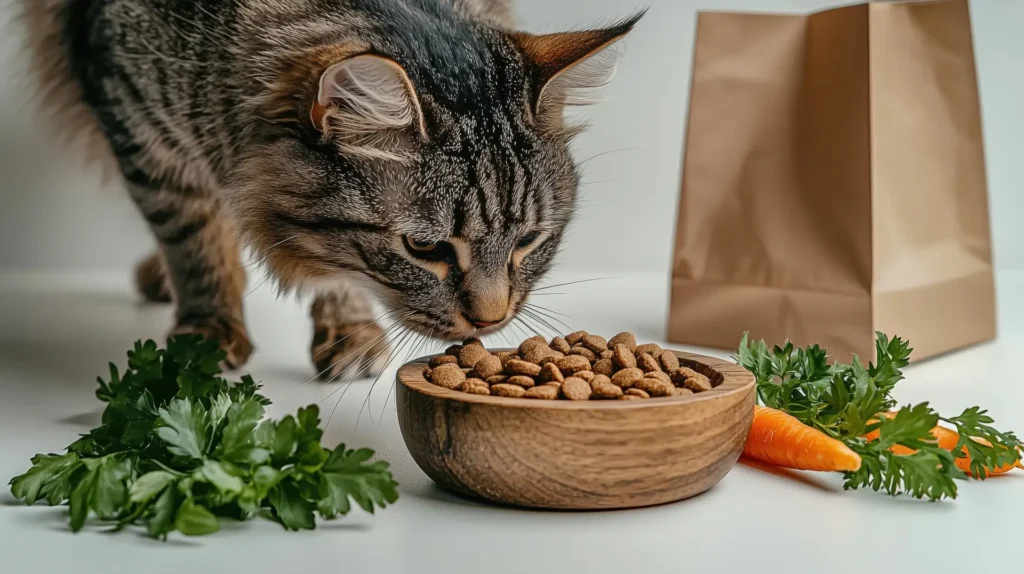Breeding Birman cats is a rewarding endeavor steeped in history, genetics, and love. In this guide, we aim to provide a complete overview of the breeding Birman cats process. Also, covering their unique traits, breeding standards, care needs, and ethical considerations.
Our focus is to share knowledge with breeders, prospective parents, and cat enthusiasts across the USA. Helping them understand, care for, and responsibly breed these gentle felines.
Understanding the Birman Cat Breed
1. Origins and Physical Traits
The Birman cat has ancient roots tied to Burmese temple lore. They are celebrated for their:
- Silky semi-long coat in rich point colors
- Deep sapphire-blue eyes
- Distinctive white mittens on paws (a non-negotiable breed standard)
- Muscular yet elegant build with rounded contours
Their soft fur makes them easy to groom. But this also means breeders must pay attention to coat health and texture.
2 Personality and Temperament
Birmans are known for being affectionate, calm, and sociable. Their gentle nature makes them excellent family pets. They thrive with attention, even from strangers. As a breeder, understanding the Birman cat’s behavior, their need for companionship and emotional bonds is essential.
Although distinct from generic Brown Cats, Birmans have a precise genetic makeup controlling their colorpoints and coat symmetry.
Planning an Ethical Breeding Program
1 Why Ethical Breeding Matters
As a Birman cat breeder, it’s critical to prioritize:
- Health screenings (e.g., for hypertrophic cardiomyopathy, PK deficiency)
- Genetic diversity to avoid inbreeding issues
- Psychological well-being is ensured by ensuring a loving, stimulating environment
These foundations support the official breed profile and help uphold your credibility.
2 Setting Up the Ideal Environment
An optimal breeding setup includes:
- Clean, spacious, and secure enclosures with vertical spaces and natural light
- Comfortable bedding and climate control to prevent stress
- Suitable nutrition, for example, pairing with a diet of the best dry cat food tailored for growth
- Social enrichment toys, interaction, and bonding routines from weaning onward
Genetics and Breeding Birman Cats Strategy
1 Coat Color and Genetics
Breeding Birman cats demands knowledge of colorpoint genetics:
- The point colors seal, blue, chocolate, lilac, red, and cream are governed by specific alleles.
- The piebald gene controls the white mittens; consistent mittens reflect high breed quality.
Balanced pairings help produce high-quality kittens. Without risking color mismatches or missing mittens.
2 Health Genetics
Genetic screenings are crucial:
- Hypertrophic Cardiomyopathy (HCM): Use echocardiograms, DNA tests, or HE screening.
- Pyruvate Kinase (PK) Deficiency: A DNA test ensures kittens are not affected or carriers.
Always partner with reputable organizations or labs for accuracy.
Reproductive Health and Breeding Protocol of Breeding Birman Cats
1 Choosing Mates
As a Birman cat breeder, seek partners with complementary strengths balance coat quality, structure, and temperament.
Health clearances should include:
- Recent HCM and PK DNA results
- Up-to-date vaccinations and parasite screenings
2 Timing the Breeding
- Females reach optimal fertility between 8-12 months.
- Birmans are seasonal breeders best times span from spring through early autumn.
- Pregnancy lasts ~63 days, and close monitoring before and after whelping is essential.
3 Supporting Queen and Kittens
- Provide high-calorie nutrition in the final trimester.
- Prepare a quiet, padded nest box free from drafts and noise.
- Weigh kittens daily, monitor nursing behavior, and schedule vet checks at 2–3 weeks.
Breeding Birman Cats: Raising Healthy, Well-Socialized Kittens
1 Early Socialization
Kittens begin social development at 3–4 weeks. Provide:
- Interaction with gentle handling
- Stimuli like toys and family interaction
- Gradual exposure to household sounds and scents
2 Nutrition and Weaning
- Begin weaning at 4 weeks using high-quality kitten formula.
- Transition to solid food over 7–10 days.
- Introduce dry kibble and wet food. Supplement with guidance from the best dry cat food advice (link).
3 Veterinary Care
- De-worming at 2, 4, 6, and 8 weeks
- First vaccinations at 8–9 weeks
- Microchipping before rehoming
Unlike the bicolor patterns of a Tuxedo cat, Birmans have full colorpoints and pure white paws.
Rehoming and Aftercare of Breeding Birman Cats
1 Screening New Owners
Ensure homes are prepared:
- Lifestyle suitable for indoor, affectionate cats
- Financial ability for long-term care
- Readiness to schedule follow-ups and consult for guidance
2 Providing a Kitten Care Package
Include:
- A sample of their current diet
- Vaccination and medical records
- A woven blanket or toy scented with mother and littermates
- A detailed care guide covering grooming, diet, and vet care
3 Staying Available
Maintain relationships with buyers. Offer:
- Post-adoption advice on nutrition, behavioral tips, and health checks
- Referral to local resources like vet clinics or feline behaviorists
Common Concerns and Expert Advice on Breeding Birman Cats
1 Coat Maintenance
Birmans have minimal grooming needs but still require weekly combing. Tangled knots, if left, can become uncomfortable. Emphasize smooth and even coat care to buyers.
2 Living With Other Pets
Birmans are adaptable; they enjoy feline and dog companions if enrichment is provided. Use gradual introductions, scent swapping, and supervised sessions for best results.
3 Managing Indoor Lifestyles
Indoor-only homes keep Birmans safe. Provide:
- Scratching posts
- Climbable structures
- Regular playtime
Compared to a long hair calico cat, Birmans have structured points and mittens.
Value Beyond Genetics
1 Emotional Well-Being
A good breeder recognizes that photo-perfect kittens are only half the story. Their mental wellness, gentle exposure, and sense of safety matter equally. Happy kittens grow into well-adjusted adult cats.
2 Ethical Responsibilities
Avoid excessive breeding, which can cause health or psychological issues.
Advocate for:
- Careful pairings
- Support for rehoming adult cats
- Rescue and advocacy efforts
Partnering with a Birman Cat Breeder Near Me
If you’re searching for a Birman cat breeder near me, consider:
- Local cat fancier associations
- Catteries with transparent health and pedigree records
- Positive testimonials and visiting policies
Asking for references, photos of adult cats, and past litters ensures you’re partnering with a responsible breeder.
Breeding Birman Cats: An Investment of Time and Heart
1 Financial Considerations
Budget for:
- Genetic testing ($150–$300 per cat per test)
- Veterinary care (prenatal, delivery, kitten check-ups)
- Registration fees and show preparation
- Nutrition and enrichment supplies
Return on investment comes from ethical reputation and strong buyer trust.
2. Time and Commitment
Expect involvement:
- Regular grooming and socialization
- Open communication with potential owners
- Evolving care as kittens grow
Raising sound kittens requires more than capital. It demands patience, empathy, and experience.
Boosting Your Breeding Program’s Reach
To grow as a respected Birman cat breeder:
- Document kitten development on social media
- Network through cat shows and local associations
- Offer mentorship or seek guidance from established breeders
- Provide educational resources on Birman traits, care, and breed standards
Final Words on Breeding Birman Cats
Breeding Birman cats responsibly involves a combination of science, passion, and ethics. It requires:
- In-depth knowledge of genetics and health
- A nurturing environment with emotional, physical, and developmental support
- Transparent communication and lifelong engagement with adopters
Whether you’re a seasoned breeder or starting your journey. This guide aims to help you raise healthy, joyful Birmans who exemplify the best of the breed.
FAQs
1. How much does it cost to breed a Birman cat?
Breeding costs vary, but genetic testing ($150–$300), veterinary care, nutrition, and registration fees can total $1,000–$2,500 per litter.
2. At what age can a Birman cat breed?
Females can safely begin breeding between 8–12 months. Although many breeders wait until maturity at 2 years to reduce health risks.
3. How many kittens does a Birman typically have?
The average Birman litter size ranges from 3–6 kittens. Though this can vary based on the individual cat’s health and genetics.
4. Are Birman cats hypoallergenic?
No cat is fully hypoallergenic. However, Birmans often produce fewer allergens than other long-haired breeds. Which may be better for mild allergy sufferers.
5. What are common health issues in Birman cats?
The main health concerns include hypertrophic cardiomyopathy (HCM) and pyruvate kinase (PK) deficiency. Responsible breeders test breeding cats for these conditions early to ensure healthier litters.








